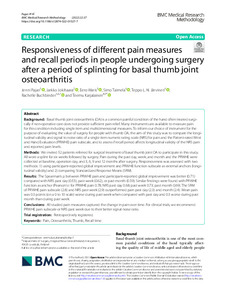Responsiveness of different pain measures and recall periods in people undergoing surgery after a period of splinting for basal thumb joint osteoarthritis
Pajari, Jenni; Jokihaara, Jarkko; Waris, Eero; Taimela, Simo; Järvinen, Teppo L.N.; Buchbinder, Rachelle; Karjalainen, Teemu (2022-02)
Pajari, Jenni
Jokihaara, Jarkko
Waris, Eero
Taimela, Simo
Järvinen, Teppo L.N.
Buchbinder, Rachelle
Karjalainen, Teemu
02 / 2022
37
Julkaisun pysyvä osoite on
https://urn.fi/URN:NBN:fi:tuni-202204263643
https://urn.fi/URN:NBN:fi:tuni-202204263643
Kuvaus
Peer reviewed
Tiivistelmä
Background: Basal thumb joint osteoarthritis (OA) is a common painful condition of the hand often treated surgically if non-operative care does not provide sufficient pain relief. Many instruments are available to measure pain for this condition including single item and multidimensional measures. To inform our choice of instrument for the purpose of evaluating the value of surgery for people with thumb OA, the aim of this study was to compare the longitudinal validity and signal to noise ratio of a single item numeric rating scale (NRS) for pain and the Patient-rated Wrist and Hand Evaluation (PRWHE) pain subscale, and to assess if recall period affects longitudinal validity of the NRS pain and reported pain levels. Methods: We invited 52 patients referred for surgical treatment of basal thumb joint OA to participate in this study. All wore a splint for six weeks followed by surgery. Pain during the past day, week, and month and the PRWHE were collected at baseline, operation day, and 3, 6, 9 and 12 months after surgery. Responsiveness was assessed with two methods: 1) using participant-reported global improvement and PRWHE function subscale as external anchors (longitudinal validity) and 2) comparing Standardized Response Means (SRM). Results: The Spearman’s ρ between PRWHE pain and participant-reported global improvement was better (0.71) compared with NRS past day (0.55), past week (0.62), or past month (0.59). Similar findings were found with PRWHE function as anchor (Pearson’s r for PRWHE pain 0.78; NRS past day 0.68; past week 0.73; past month 0.69). The SRM of PRWHE pain subscale (2.8) and NRS past week (2.9) outperformed pain past day (2.3) and month (2.4). Mean pain was 0.3 points (on a 0 to 10 scale) worse during past week when compared with past day and 0.3 worse during past month than during past week. Conclusions: All studied pain measures captured the change in pain over time. For clinical trials, we recommend PRWHE pain subscale or NRS past week due to their better signal noise ratio. Trial registration: Retrospectively registered.
Kokoelmat
- TUNICRIS-julkaisut [16929]
